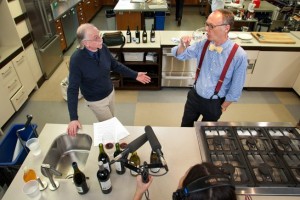
Every retail wine shop worth its salt ought to be part clinic, a place where problems can be addressed and resolved. In the wine corner at Formaggio Kitchen in Cambridge where I work, for example, we spend time showing folks how to use a waiter’s corkscrew to open a bottle of wine safely (and with a certain panache) and demonstrate how to perform a hard decant (a technique that can bring even the most recalcitrant wines to heel). We also field the usual “what wine do I drink with swordfish?” kind of queries.
Sometimes issues arise that really do make us feel like clinicians. I’m thinking of folks who tell us that they either have to carefully restrict their intake of red wine or have given it up all together. I’m not a doctor and don’t try to play one, but in a case like this, I will often ask for some details on the kind of red wine they typically consume.
Before I go further, I should explain that not all red wines are built the same way because they don’t all have the same phenolic load. Let’s unpack this.
Phenolics are a large class of chemical compounds found in all wines but in varying abundance in red wine. A shorthand way of describing them is to say that they’re the things that make red wine red. In other words, phenolics are naturally occurring compounds that add the body, texture (tannin), and color (pigment) that lend red wine its character.
The richer the phenolic content, the more there is for a sensitive person to react to—as a result, one might suffer headaches, flushing, sinus congestion, or other uncomfortable or downright nasty symptoms. What precisely is the culprit? Since there are literally thousands of organic compounds in red wine—we haven’t even identified all of them—it may be impossible to know for sure.
These reactions are the kind of painful consequences that would justify anyone’s decision to swear off red wine altogether and opt for a whites-only strategy. But for at least some sufferers, there is a viable alternative: choosing red wines less rich in phenols. Several of our clientele have had success with this technique.
How is it that red wines can differ so widely in phenol content? One factor is the character of the grape variety involved. Cabernet sauvignon, for example, is natively richer in phenols than, say, pinot noir or gamay. Another issue is how much ripeness the fruit attains or can attain where it is planted. Thus, cabernet planted in a warm climate site will typically be richer in these compounds than the same varietal grown in cooler places—at higher latitudes or at higher altitudes.
A third determinant has nothing to do with natural conditions. Rather it’s the degree to which the winemaker extracts what is present in the grape. We frequently point to brewing tea as analogous to the process by which red wine is made: Both are infusions. The amount of tea and the length of steeping time determine how strong a cup we brew. A vintner is in control of how the grapes are extracted and find their way into the finished wine. Generally, more determined extraction translates to a greater phenolic load.
So, assuming you’re sensitive to red wine, how do you know—or how can you guess—when you’re looking at a wine that might be safer to drink? The surest way is always to query the somm if you’re in a resto, or the staff at your local retail shop. What you’re looking for are reds that are lighter in body than the norm, either because of the grapes they’re made from or because they are sourced from cool-climate vineyards where varietals more rich in phenolic content can’t be ripened and so aren’t planted. Some obvious varietal choices are gamay, cool-climate pinot, freisa, grignolino, trousseau, poulsard, pinot d’aunis, and schiava nera. Cool-climate vineyards are found in northern Italy, France’s Jura region, Germany (yes, some red is made there), the higher elevations in Burgundy’s Côte d’Or, and many other places.
The three wines we used in our Test Kitchen Radio segment were the 2014 Domaine des Terres Blanches “Pot d’Vache” Gamay de Bouze, the 2014 “Ca’ Fiui” Valpolicella from Corte Sant’ Alda, and the 2014 Gaspard Saint-Pourcain Pinot Noir.
It bears saying that you do not need to be concerned that giving up dense, concentrated wines means you will enjoy drinking less. A period of adjustment may be required, but once you’ve had some experience with these wines, you will appreciate their delicacy, freshness, and appetizing character.
If you’re wondering where additions of sulfur fits into all this, I can tell you that if white wines do not afflict you in the same way that reds do, the chances are good that sulfur is not the culprit. This is because conventionally made white wines are generally much higher in sulfur content than reds.
One final and important bit of advice: Use your camera phone to snap a photo of red wines that don’t produce symptoms. Eventually, you’ll begin to get a sense of the grape varieties, the regions, and the estates that make red wine you can tolerate—and take pleasure in.
Stephen Meuse can be reached at stephenmeuse@icloud.com